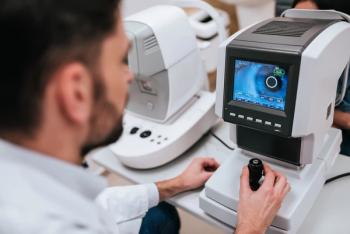
- July/August digital edition 2025
- Volume 17
- Issue 04
A case of orthokeratology for high myopia
Paul Levine, OD, FAAO, FIAOMC, details a pediatric case of high myopia in which the patient's prescription had increased from –5.75 DS OU to OD –7.00 DS, OS –6.75 DS within a year.
Anna was a 12-year-old White female referred to me by a local optometrist for myopia management. In the year prior to seeing me, her prescription had increased from –5.75 DS OU to OD –7.00 DS, OS –6.75 DS. Interestingly, she did not have a family history of high myopia. Her previous optometrist had attempted to fit her into Biofinity multifocal contact lenses (CooperVision) to help manage her myopia, but she could not tolerate the distance blur and reverted to single-vision spectacles. She had not been measured for axial length before seeing me for the first time.
Initial visit 8/13/2019:
Wearing (2/28/2019)
OD: –7.00 DS = 20/30
OS: –6.75 DS = 20/25
Cover testing ortho at distance and near, full range of ocular motilities, NPC to the nose, normal color vision and pupils. NRA/PRA +3.25/–2.50.
Subjective refraction:
OD: –7.00 –0.75×180 = 20/20
OS: –7.00 –0.50×155 = 20/20
Cycloplegic refraction:
OD: –7.00 –0.50×180
OS: –6.75 –0.25×165
Baseline axial length (Zeiss IOL Master): OD, 27.35 mm; OS, 27.44 mm
IOP: 15 mmHg OU
Dilated fundus examination unremarkable, cup-disc ratios 0.20 OD and OS.
Anna’s appearance was of a healthy girl of average height and weight. She presented with her mother, who was tall (approximately 5 ft, 10 in). I mention this because when assessing Anna’s risks for progression, at 12 years old, she had not yet had what I anticipated to be a rapid growth spurt based on her mother’s height. (Today, at 17 years old, Anna is approximately 6 ft tall.)
All options for managing myopia were discussed, including bifocal spectacles, atropine, soft daily disposable bifocal contact lenses, and orthokeratology (ortho-k). The patient and her mother were most interested in ortho-k. I explained that proceeding with ortho-k would be considered off-label as the FDA approvals for myopia stop at –5.00 or –6.00, depending on the lens used. I also explained that although I thought it would be successful in slowing her progression, I explained that full correction might not be attainable, and in that case, she might need to use glasses for any residual myopia not molded out. I also explained that study results showed that partial correction with ortho-k will likely decrease progression similar to full correction.1 After our discussion, it was decided to proceed with ortho-k.
To further complicate Anna’s situation, her baseline keratometry values were particularly flat, and her corneas were very large, with higher-than-average E-values (Figure 1). However, her corneas had a very regular topography with well-centered corneal caps. There was a small amount of corneal cylinder, which closely matched her refractive cylinder.
Corneal molds were designed using custom-design software (Wave). To properly align the corneas, toric alignment zones were utilized with a spherical base curve. The decision was made by evaluating the elevation maps of the corneas (Figure 2) and understanding that refractive and corneal cylinders matched, allowing for the spherical base curves.
Lenses were designed as discussed with toric alignment zones and spherical base curves. Diameter was set at 95% of horizontal visible iris diameter, Jessen factor was increased to +2.25, a smaller treatment zone was used due to high myopia, and sagittal height of the lenses was lowered in the flat meridian to account for the high E-values (Figure 3). The sodium fluorescein patterns were as shown (Figure 4).
Anna was seen on day 1 after sleeping in the lenses for the first time. The results showed well-centered bull’s-eye patterns beginning to form (Figure 5). However, she was only able to see 20/400 letters sans correction. Her refraction on that day was as follows:
OD: –4.75 –0.50×180
OS: –3.50 –0.75×155
Anna was given soft contact lenses to use for the first few days of treatment because her vision was not yet functional without correction, but her current spectacles were much too strong.
At the 1-week follow-up appointment, the topographies showed well-centered bull’s-eye patterns, mostly formed (Figure 6). Her refractive results on that day were as follows:
Visual acuity without correction (VA sc):
OD: 20/60, OS: 20/30+2, OU: 20/25
Manifest refraction (MR):
OD: –1.50 SPH
OS: –0.50 SPH
Based on the topographies that day, one may be compelled to adjust the fit of the right lens. It can be stated that the left eye topography shows a more complete red ring than the right eye, and the blue treatment zone appears thinner and less dense in the right eye. This would likely account for the uncorrected myopia in that eye. It was also possible that the target power of the right lens might need adjusting by flattening the base curve. Hasty changes should be cautioned against, and as such, the lenses were to be continued as is and be reassessed 2 to 3 weeks later.
Anna returned 1 month post fitting with the following results and topographies (Figure 7).
VA sc
OD: 20/20 OS: 20/20 OU: 20/20
MR
OD: Plano SPH
OS: –0.25 SPH
Allowing the lenses, particularly the right lens, more time provided full correction of Anna’s myopia. No further changes were made, and she was to be seen again at 3- and 6-months post fitting, then every 6 months thereafter. After 5.5 years of wearing ortho-k, Anna has not needed to be refitted to stronger molds. Although her axial length showed slight increases over that time (Figure 82), she has not shown any signs of myopia progression. Over the past 5.5 years, Anna has grown from a 12-year-old of average height to a 17-year-old who is almost 6 ft tall, and her myopia had increased by 1 D the year prior to starting ortho-k.
As of October 2024, Anna still has 20/20 vision with minimal to no refractive error. To date, the base curve and target power of her lenses have not changed since her original fitting in 2019. Based on the normal changes in axial length, stable acuity, and refraction, Anna’s myopia progression was completely arrested. Due to the impracticality of washing her out to confirm the current amount of myopia, we must rely on refractive and biometric measurements to justify that.
References:
Charm J, Cho P. High myopia-partial reduction orthoK: a 2-year randomized study. Optom Vis Sci. 2013;90(6):530-539. doi:10.1097/OPX.0b013e318293657d
Gifford KL, Richdale K, Kang P, et al. IMI - clinical management guidelines report. Invest Ophthalmol Vis Sci. 2019;60(3):M184-M203. doi:10.1167/iovs18-25977
Articles in this issue
4 months ago
Myopia is an escalating global health crisis4 months ago
Inside genetics and glaucoma5 months ago
Embracing dry eyeNewsletter
Want more insights like this? Subscribe to Optometry Times and get clinical pearls and practice tips delivered straight to your inbox.










































